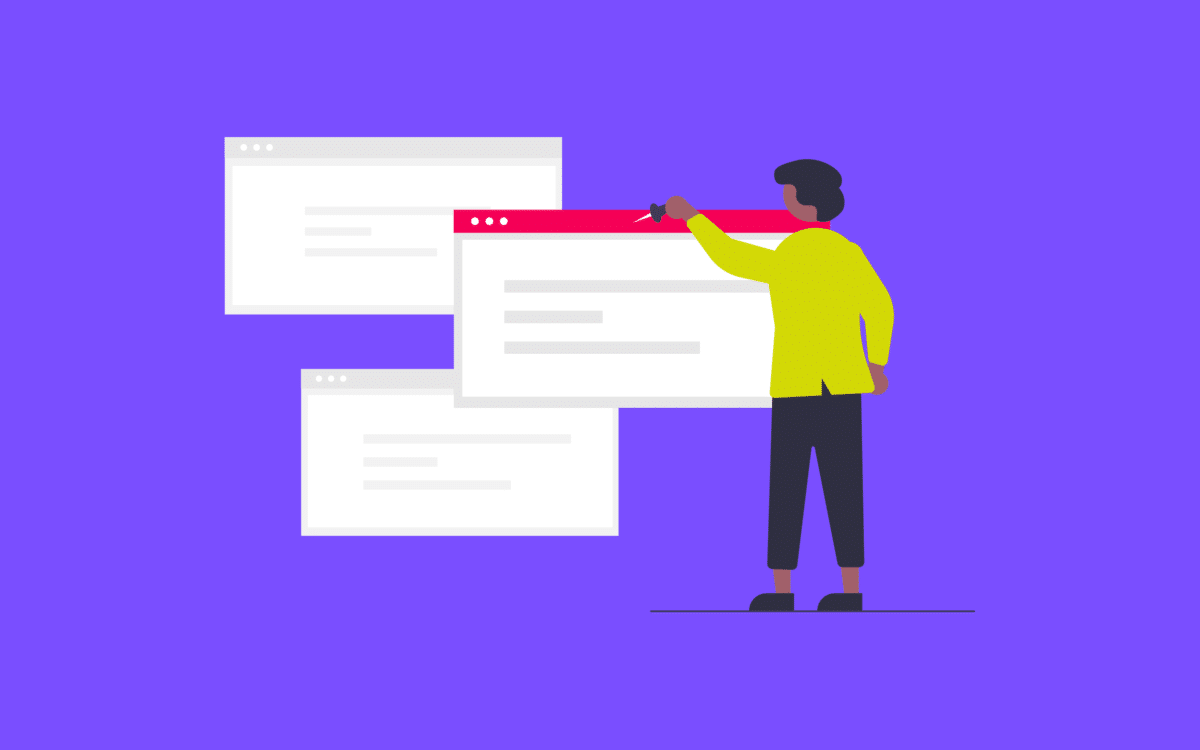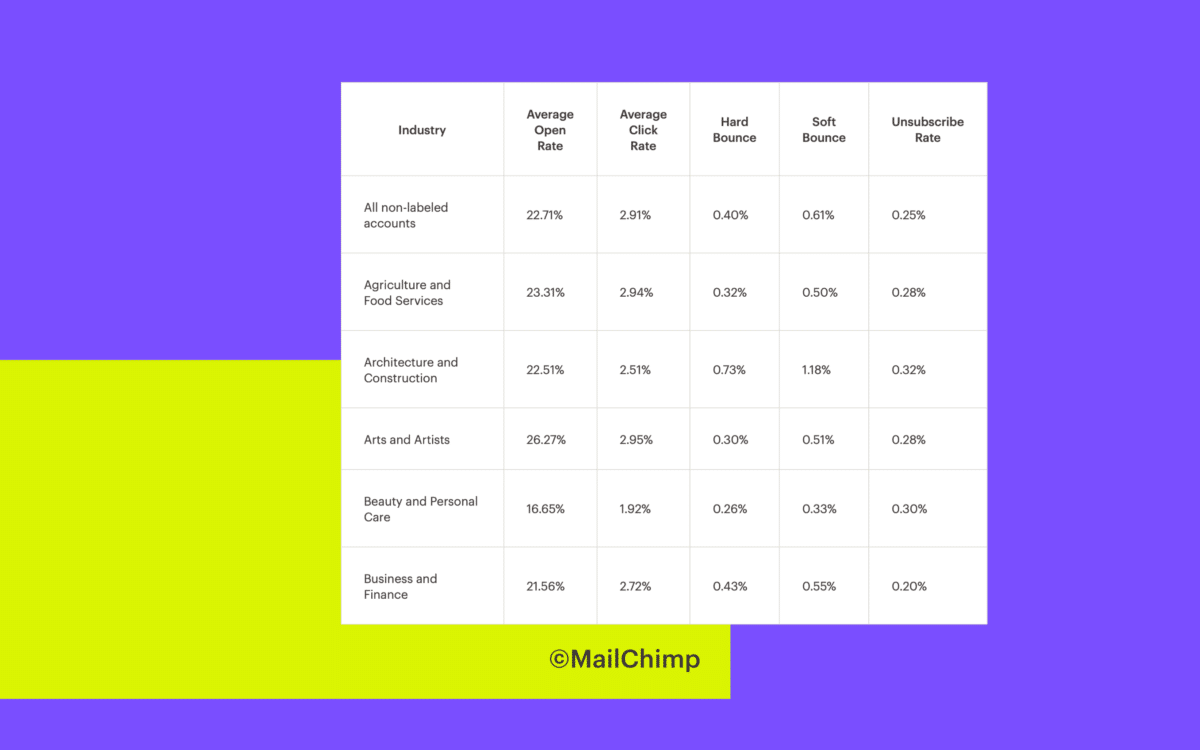What is a good open rate for email marketing?

When it comes to measuring the success of an email marketing campaign, a good email open rate is a common metric to measure.
After all, you can’t accomplish much with your email strategy if you can’t convince people to click onyour emails and open them first.
The average open rate for email marketing campaigns often varies depending on the industry you’re in, your target audience, and the kind of messages you’re sending.
However, knowing what kind of numbers are reasonable for a company like yours can help you to better understand how successful your current strategies really are.
Today, we’re going to introduce you to the basics of email open rates, and what kind of numbers might be good for you.
Defining the email marketing open rate
To get a good idea of what your average newsletter open rate should be, you first need to understand what this metric actually measures.
The “open rate” of your emails is the number of people who open and see your emails. You can look at this number as a percentage by comparing the number of people who open your messages to the number of emails you send.
Email service providers (like Gmail and Outlook) calculate open rates by talking the number of people who open your emails and dividing it by the number of emails sent that reached the recipient.
In other words, emails that bounced or didn’t arrive in their destination aren’t included here.
If you send 100 emails, say, and 10 of them don’t get delivered, you’re left with 90 emails. Of those 90 emails, maybe about 30 will be opened. That means leads are opening about a third of your emails, or 33%.
There are various factors that can affect the open rate of your email marketing efforts, including:
- List quality: If you’re sending messages to people who don’t really want to hear from you, the chances are that your open rates will be lower. That’s why it makes sense to confirm your subscribers with double opt-in practices.
- Brand recognition: Customers are more likely to open emails from your company if they recognise your brand. Using a personalized “from” name like “Stewart from Fabrik”, is helpful too, as it makes your message feel more human.
- Sender reputation: If you’ve been flagged as spam by a lot of users in the past, or you’re sending your emails from a less than reputable email marketing tool, then your sender reputation could be suffering. Make sure you protect your rep by avoiding the spam and junk filters when you can.
- Subject lines: Does your subject line match your tone of voice? How likely is that subject line to capture your customer’s attention and gain their interest? Can you make it more enticing with an offer, or a set of emojis?
- Sending time: The time or day that you send an email can have a huge impact on open rates. The key to success is often figuring out when your customers are most likely to be online, and when they’re going to be susceptible to your message.

The benefits of a good email open rate
So, why is it so important that companies strive for a good email open rate?
A lot of marketers make the mistake of focusing exclusively on other metrics when examining email performance, like conversion or click-through rates. However, nothing in your email is going to have the right impact on your audience unless they open it first.
A high open rate tells marketers several important things about their email strategy, including:
- Whether the subject line and offer was effective.
- If the “to” name is making the right impression.
- Whether the pre-header or preview text was engaging.
- If the email was correctly targeted towards the right audience.
- Whether the email was blocked by spam filters.
Although the open rate is just one of the metrics worth considering when assessing the value of your email marketing strategy, it’s something you definitely can’t afford to ignore.
According to most experts, your average email open rate should be between 15 and 25%, indicating that at least one in five of your customers are clicking on the messages you send, and getting your message.
If your open rate is less than 15%, then there’s a good chance you’re missing something.
Most email software providers will allow you to see your average open rate as one of the metrics on your dashboard. You can calculate the percentage yourself by dividing your number of contacts that clicked on the email by the number of people who received the message.
Even if your open rate is fairly good, remember, there’s always room for improvement.
Email marketing average open rate insights
Notably, while it’s a good idea to aim for an average open rate of around 15-25%, it’s also worth remembering that average open rates vary depending on which industry you’re in, and what kind of emails you’re sending.
For instance, willingness to open promotional emails varies somewhat when you compare the B2C and B2B segments.
B2B emails generally have an average open rate of around 20.8%, while B2C messages have an open rate of around 21.9%. This means that consumers are slightly more likely to click on promotional emails than their business counterparts – but not by much.
For an insight into how the best email open rates vary by industry, let’s take a look at some of the averages for most sectors.
This data comes from the Mailchimp 2019 benchmarking report:
- Consulting: 20.13%
- Business and finance: 21.56%
- Creative services: 21.39%
- Professional services: 21.94%
- Real estate: 19.17%
- Travel and transport: 20.44%
- Hobbies: 27.74%
- Agriculture and food: 23.31%
- Arts and artists: 26.27%
- Beauty: 16.65%
- Computers and electronics: 19.29%
- eCommerce: 15.86%
- Government: 28.77%
- Home and garden: 21.6%

As you can see, although the average rates vary quite a bit here, most of them linger around the 20% mark, making the 15-25% open rate recommendation a pretty realistic one for most.
Notable, as we mentioned above, different kinds of emails also have different average open rates.
Welcome emails, for instance, usually have a high open rate of around 57.8%.
Transactional emails, which you usually send to a customer to confirm their purchase, have an open-rate of around 80-85% too.
Promotional emails usually hang around 21.33% with their open rate but adding personalized elements to your subject lines increases the average to around 22.63%.
You’ll get a better insight into how open rates change with your customers based on commercial intent when you’re checking out your analytics.
The reports available in your email marketing software will show you how frequently people open your emails and, when exactly they’re more likely to open them too.
Remember, it’s not just your chosen industry that effects open rates.
In the retail industry, open rates on Sundays average out at around 14.9%, while they’re only 13.7% on a Friday. Days and times make a huge difference to your chances of success.

How to improve email open rates
If your email open rates aren’t as great as you’d like, or you’re not meeting the average for your industry, then you could consider looking for ways to improve your numbers. Improving your email open rates should have a direct impact on your conversions too.
The more you learn about your audience, industry, and what convinces people in your sector to click on emails, the easier it will be to upgrade your open rates. In the meantime, try some of these best practices and measure your results:
1. Enhance your subject lines
There are only a handful of things about your email that you can control when it comes to improving your open rates – your subject line is one of them. Don’t just settle for headers that seem “good enough”.
Think about what kind of headlines are really going to impress your target audience.
A good tip is to look for ways to engage your audience with the subject line, by introducing an important benefit or something that you know they’re interested in. Headlines should provoke an emotion, get people thinking, or demonstrate instant value.
Numbers in your subject lines can grab attention in a sea of text, and emojis may be a good idea if they suit your brand personality. These unique shapes make your messages stand out from the crowd.
2. Master your preview text
Following the subject line, the preview text is another handy way to grab customer attention. Depending on the email client that your readers use, they’ll see between around 30 and 140 characters in total, which means that you need to make a statement with eye-catching words.
An action phrase like “get 10% off your purchase” inspires your audience straight away. Grab the reader’s attention and make sure that both your subject line and preview text align perfectly before you start sending.
You might want to consider sending a test email first to see how the preview text might look.
3. Ensure emails are deliverable
Surely all emails are “deliverable” right? Well, not necessarily. Email deliverability measures the likelihood that your messages will reach the inbox of your audience, without being bounced, or rerouted to the spam filter.
There are various factors that can influence deliverability, so here are a few ways to boost your chances if hitting the inbox:
- Manage your list: Always ask customers to double opt-in so you know they want to hear from you. Clean your list regularly of any subscribers who aren’t engaged.
- Deal with compliance issues: All email marketing campaigns sent to your customers need to comply with international and national regulations. If you’re connecting with people in the EU, for example, you need to comply with GDPR.
- Proofread: A lot of spam filters look at spelling and poor grammar as evidence of greater risk. The same goes for writing parts of your email (including your subject line) in all-caps. Tools such as Grammarly or Ivory Research can help you to avoid making these mistakes.
4. Always send valuable content
If the people subscribed to your email list see value in your messages, they’ll be far more likely to open the following messages they get from you.
If they’re constantly dealing with spammy messages that aren’t catering to their interests on the other hand – you’re going straight to the spam folder.
Think about how you can deliver the most value with every message. Segmenting your audience so you can send personalized offers and information based on individual needs is a great start.
It’s also worth checking your email marketing analytics to see which emails generate the best metrics. Messages with a high click-through rate are usually the ones your customers like most.
5. Change the frequency
We’ll talk more about the importance of choosing the right email frequency in a future article. For now, just know that sending too many or too few emails can be a recipe for disaster in the email world.
Too many emails mean that your customers will feel overwhelmed. They might get sick of seeing you in their inbox and start sending you into their spam folder instead.
Send your emails too infrequently, on the other hand, and you risk being drowned out by other messages. Particularly in the B2B world, most customers are sorting through hundreds of emails each week. Your message and brand impact can easily get lost.
Experiment with different email frequencies to see which have the best impact on your open rate. If your customers have profiles on your website, you could even ask them to choose how often they want to receive emails, and what they want to hear about in their settings.
6. Make your emails accessible
There are a few ways to define accessibility when it comes to email marketing and getting a good email open rate. You might want to use contrasting colors in your templates to make your messages easier to read, while the option to switch out of rich text format might appeal to customers who can’t open fancy email designs.
One of the easiest ways to make sure that customers can open and view your emails, is to make them mobile friendly. Around 41.9% of customers said they open emails in a mobile email client in 2019, and the number of smartphone users is growing.
Optimize email for mobile with shorter subject lines, scannable body text and easy-to-click call to action buttons.

Do more subscribers = a better open rate?
By this point, you should have a good idea of what the email marketing average open rate is for your industry, and what you can do to start generating more successful engagement. However, there’s one golden piece of advice that we have left to give.
Having more subscribers to your email list won’t necessarily mean that you benefit from more engagement.
A lot of business owners still make the mistake of thinking that the more emails they send out, the higher their chances of purchases will become. Unfortunately, if you’re sending emails to people who aren’t really interested in what you’re selling, your open rate will still suffer.
The more those customers send your emails into their spam box, or delete them, the worse your sender reputation becomes.
That’s why making sure that you’re targeting the right audience is the key to better open rates. Knowing who you’re targeting means that you can personalize your messages to the people who want to read them.
Remember, 88% of marketers see a measurable improvement in campaign outcomes when they personalize messages.
Choosing your subscribers carefully also means that you minimize the number of emails that never actually get to your customer’s inbox.
Using double opt-in is a great way to reduce your risk of uninterested and unengaged subscribers. This basically means that you send an email asking your audience to confirm their subscription before your email campaigns begin.
Other ways to increase your sender reputation include asking your readers to add you to their list of trusted addresses. This is something that most email clients can offer, and it’s a great way to avoid unintended trips to junk mail.
Finally, remember to cleanse your email list regularly. If subscribers don’t open an email from you for a few months in a row – take the hint. Sending endless emails to someone who doesn’t want to receive them won’t get you more sales.
Improve your email marketing open rate
The average open rate for email is just one of the metrics you need to consider when you’re evaluating the success of your marketing campaigns.
Other KPIs, like how often your customers click through to your website to check out your products, and how frequently they share your emails can offer some helpful insights too.
However, if your clients aren’t opening your messages, it’s fair to say that you’re going to struggle to convince them to do anything else.
Working on your open rates and ensuring that customers feel comfortable interacting with your business will help you to strengthen brand relationships and earn new sales.
How do your email open rates compare with the industry average?
Fabrik: A branding agency for our times.
Now read these:

















